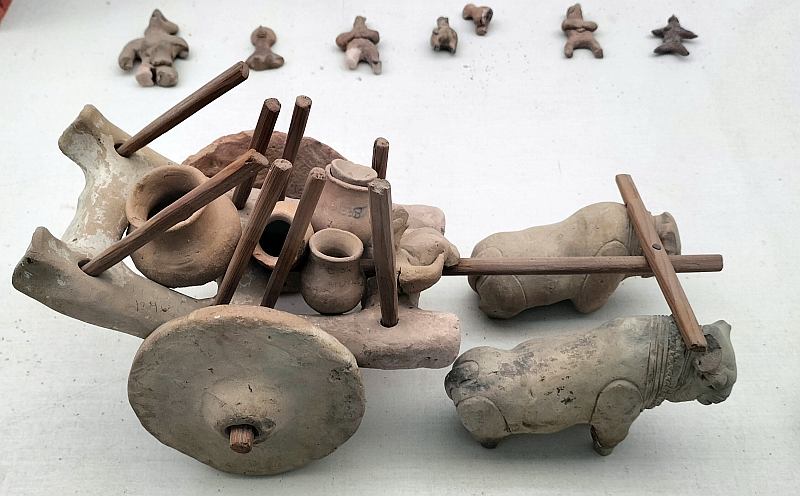Indus Valley Civilization – The Ancient Urban Culture of Pakistan

The Indus Valley Civilization is the earliest known urban culture on the Indian subcontinent. It was first identified in 1921 at Harappa in the Punjab region and then in 1922 at Mohenjo-daro near the Indus River in Sindh. Both sites are now in Pakistan. Later, smaller remains of this civilization were rediscovered in Pakistan at Sutkagen Dor near the Arabian Sea, about 480 km west of Karachi, and in India at Ropar, 1,600 km to the northeast in the foothills of the Shimla Hills.
Further excavations were carried out near the Gulf of Khambhat, 800 km southeast of Karachi, and in the Yamuna basin near Delhi. This makes the Indus Civilization the most extensive of the world’s three earliest civilizations—alongside Mesopotamia and Egypt, which began slightly earlier.
Major Cities and Urban Planning
The Indus Civilization had two major cities—Harappa and Mohenjo-daro—along with over a hundred smaller towns and villages. Each city likely covered about one square mile and required significant political organization. Evidence suggests the existence of either two powerful states or a centralized empire with alternating capitals.
Harappa may have risen after Mohenjo-daro, which was destroyed more than once by devastating floods. The southern regions, including the Kathiawar Peninsula, seem to have developed later. The civilization had a written script of about 250–500 characters, tentatively identified as Dravidian. Its peak period was between 2500 and 1700 BCE, though southern sites may have lasted longer into the second millennium BCE.
Origins, Agriculture, and Trade
The Indus Civilization evolved from earlier villages, adopting Mesopotamian-style irrigation agriculture to harness the fertile Indus plains while controlling its powerful floods. Expansion along the river supported a growing population sustained by rich agriculture and trade.
The people cultivated six-row wheat, barley, peas, mustard, sesame, and dates, and possibly flax. Domesticated animals included dogs, cats, cattle, fowl, pigs, camels, and buffaloes. Elephants were also domesticated, and their ivory was widely used.
Trade brought valuable minerals from distant regions: gold from southern India or Afghanistan, silver and copper from Rajasthan and Afghanistan, lapis lazuli from Afghanistan, turquoise from Iran, and green fuchsite from southern India.
Art, Seals, and Craftsmanship
The civilization’s most famous artifacts are its small steatite seals, featuring finely carved depictions of animals such as elephants, tigers, rhinoceroses, and mythical creatures. Some seals and stone sculptures portray human or divine figures. Numerous terracotta figurines of animals and humans have also been found, showcasing remarkable artistry and symbolism.
Decline and the Aryan Invasion
The decline of the Indus Civilization remains uncertain, and it may not have ended uniformly. However, Mohenjo-daro’s destruction was sudden and violent. Around 1500 BCE, invaders attacked the city, leaving victims where they fell. The Rigveda, an early Aryan text, describes warriors led by the god Indra attacking fortified cities, which aligns with this event.
Before the invasion, Mohenjo-daro was already in decline—plagued by floods, poor housing, and overcrowding. The final destruction ended centuries of urban life in northwestern India. Simpler cultures replaced it, influenced by Iran and Central Asia, particularly the Aryans.
Legacy and Cultural Continuity
In southern regions like Kathiawar, there appears to be a smoother transition between the late Indus culture and the Copper Age societies of central and western India (1700–1000 BCE). These cultures formed a vital bridge leading to India’s Iron Age civilization around 1000 BCE.
In recognition of its global importance, the ruins of Mohenjo-daro were declared a UNESCO World Heritage Site in 1980.
Footnotes
- UNESCO World Heritage Gallery
- “Indus Civilization” or “Indus Valley Civilization”
- The Rigveda is a collection of ancient hymns written during the Vedic period, describing early Aryan society in northwestern India. It contains over 1,000 hymns and 10,500 verses, dating from around 1700–1100 BCE, and remains an active part of Hindu rituals today. (Learn more)
- UNESCO World Heritage Site: Mohenjo-daro
Sources
- MLA: “Indus civilization.” Encyclopædia Britannica Ultimate Reference Suite. Chicago: Encyclopædia Britannica, 2010.
- APA: Indus civilization. (2010). Encyclopædia Britannica. Chicago: Encyclopædia Britannica Ultimate Reference Suite.


Advertise on this site click for advertising rates

